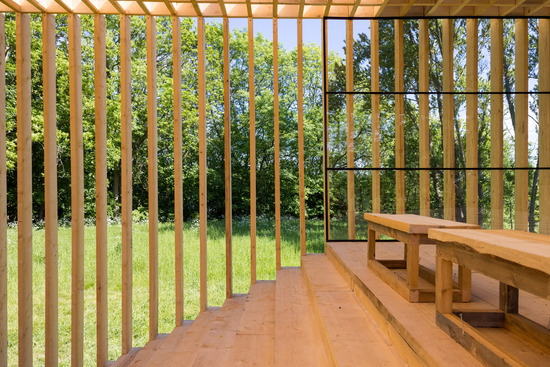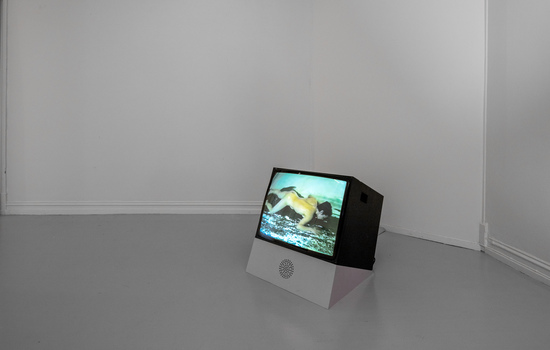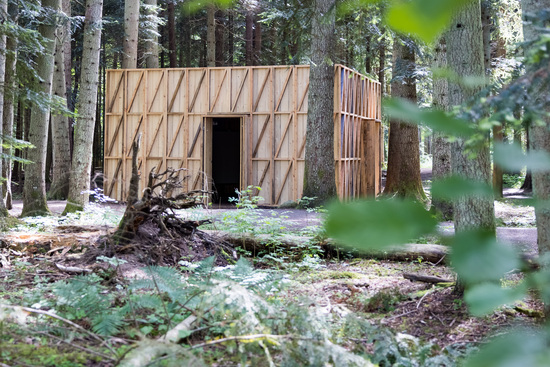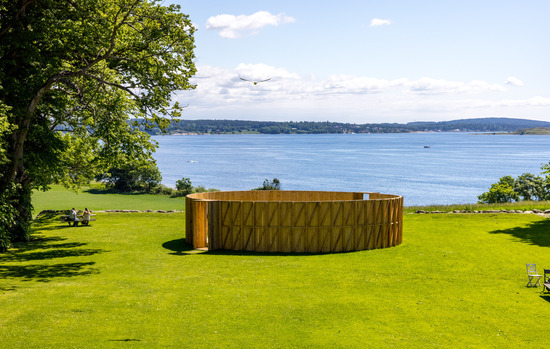Forty minutes on a fjord-side train journey from Oslo is Moss. A modest harbour town which now straddles the mainland and island of Jeløya, with a history of paper and spirit making – both now deserted industries – and home to Momentum Biennial. Organised by Galleri F 15, a contemporary gallery dating from 1966 residing in a grand estate home within carefully managed farming and natural landscapes.
Jeløya has a rich artistic heritage as the site of escape for Edvard Munch who holidayed on the island, painting its landscape and occupants. A walk to Galleri F 15 through the town’s suburbs then woodland tracks passes marking posts outlining Munch’s relationship to the place, talking to his personal and painterly history there. The island—which only became one in the 19th century after a canal carved off the Jeløya peninsula—comprises cultural, historic and natural landscapes as palimpsests. With Munch and Momentum, art is compressed into that mix.
Until this edition, Momentum has been sited at the F 15 house and across Moss, including in a collection of grand set piece of industrial buildings in the town. Since the last Biennial, however, these industrial remnants have been transformed into a predictable (if pretty) district of restaurants, wine bars and apartments. The transformation of post-industrial landscapes following art injection is not a new story, and with the rise of the biennial industry, a particular boosterism is added to the toolkit of gentrifying developers, authorities and placemakers.
There are now around 250 biennials and triennials, following a rapid rise over the 21st century as cities around the world sought to mark their place on the artworld map. This follows the Bilbao effect of Frank Gehry’s contemporary explosion, but most cities can’t afford a starchitect icon and the biennial industry offers a drip, drip of cultural power that can easily be folded into other boosterist activities – city branding, tourism, speculative development – in a handily replicable model from Adelaide and Bangkok to Whitstable and Yokohoma.

But, how to make a biennial unique and personal to the place where artists and ideas are spread thinner across a globalised and competitive market? Sometimes the unique urban location sets the agenda, as with the godmother of all Biennials, Venice, when each year art or architecture inserts itself into palazzos, pavilions and chapels. Others, such as Folkestone Triennial, developed a community-led model whereby some of the works of each edition get left as a legacy, nearly 100 site-specific and unique artworks fill the streets.
The main method of developing identity is through curatorial approach, and an ever-growing industry of freelance curators now exist to drop with themes, strategies, contacts and programmes. For Momentum 11, director Dag Aak Sveinar appointed curator Théo-Mario Coppola to oversee the project, developing the theme of a ‘House of Commons’ to explore ideas of togetherness and horizontality, drawing upon the notion of the commons developed by Elinor Ostrom. Then Coppola was sacked days before the official opening date, the organisation claiming a serious breach of contract and lack of delivery of critical texts, statements and descriptions, calling it "unexpected and traumatic."
The curator, in return, posted an open letter on the website www.momentum11.art saying their role as director "was undermined," withdrawing themselves, the title and texts from the project. The biennial has since relaunched with "an opening without a curator," acknowledging the ruptured process which somewhat belies the curatorial underpinning of the whole thing. In a public statement, they add that "it has allowed for opportunities for reflection on what constitutes collaboration, solidarity and contractual relationships, as well as the roles and responsibilities of curators, institutions, production teams, participants, artist-practitioners and supporters in larger-scale projects like biennale."

The lack of critical text, supporting literature and curatorial framework is obvious. There are some beautiful works in the show, but no publication and minimal framing texts (which are then only accessible on an awkward website), with any connection between and around works is left up to the individual visitor. The opening work, a 1996 video performance by Pia Arke, the artist nakedly crawling over and slowly ripping up a large-scale print of a Greenland landscape, is frantic, speaking not only to the Piblokto hysteria experienced on long arctic nights, but also in 2021 to existential anxieties reiggered by Covid and the climate.
Cian Dayrit’s ‘Tree of Life in the State of Decay and Rebirth’ hangs on the wall, a textile work mapping neoliberal political forces, currently shown as an artwork, but feeling like it is ready to be grabbed and taken into the streets as a protest banner at any moment. A found object of a tiny section of subterranean cable junction sits discarded on the floor, the artist Nina Canell choosing a junction where one cable is connected to a bundle. Or perhaps a bundle consolidating into a single.
Scattered around the gallery are elements of a Maria Nordom work, all the elements of a flat-pack micro-house which has been dismantled and sculpturally located in piles and bundles around the F 15 house, distributed wooden elements that could be gathered together to form shelter. Wooden architectures are also scattered amongst the landscape, and it’s here that the Biennial – which would otherwise perhaps feel more like a group show – explores a sense of unique identity. Three large wooden pavilions designed by Mexican architects S-AR are dotted around the garden, woods and clearings, inviting the visitor to leave the house and take in a trail exploring the cultural and natural setting.
The most visible of these is the Cylinder Pavilion (main picture), bang in the middle of the formal lawn between house and expanse of fjord. Inside it has a unique acoustic, a small stage and edge benches, a space which can be adopted for any use, and over the autumn will be co-opted by community groups and artists to present a series of pop-up interventions.

Two other pavilions find their own place in landscapes, offering sensorial relationships to the nature, history and sites. The Stairs Pavilion taking up the site of a former estate worker’s cottage tucked out of sight of the main house, and the Platform Pavilion squeezed within newly cleared pine trees, the first few felled in a renaturalising process that will see the invasive and dominating pines removed in a process of delicate landscape management. Both pavilions contain film works, including the moving tryptic Islands of Memories by Siri Hermansen, looking at the generational handing down of memory and trauma in German families after the Second World War.
The question of how these pavillions offer a relationship to place perhaps offers a direction of travel for Momentum. Having left the industrial warehouses behind, and still rocking in the wake of this edition’s political turbulence, it is an opportunity for a progressive reimagining, escaping the traps and tropes of the biennial industry.
As we collapse deeper into the Anthropocene, a biennial which deeply considers landscape, nature and creates the conditions for an ecology of art that supports that research and rebalancing, rather than just as a stage set, could be Momentum’s unique identity. It would also further the island’s role as a site of cultural, natural and social inquiry.
Momentum Biennial runs until 10 October 2021.


